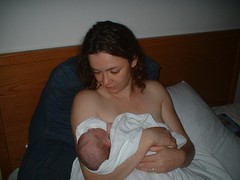Newborn Limelet
As Limelet's first birthday approaches (9/18), I was reading a great article in Mothering Magazine about the unbelievably high cesarean rates and neonatal mortality in this country. Here's a mere snippet:
Mothering, September – October 2007, p 54.
Many advocates of better birthing practices think that one of the greatest costs
of high-tech birth is the loss of traditional birthing rituals. But if rituals
are used by a people to organize and define their culture, then, Davis-Floyd
believes, we actually do have rituals around birth—it’s just that our rituals
are now based on machinery.
“The obstetrical routines applied to the
‘management’ of normal birth are also transformative rituals that carry and
communicate meaning above and beyond their instrumental ends,” she stated in an
interview. “The meaning they communicate is that high technology is superior to
biology and women’s body-knowing, and is essential to ensure the safety of
birth.
...
Nature is to be feared, technology to be trusted. This
cultural ethos prevents us from using the vast available information we have
about how to support and facilitate the normal physiology of birth without
unnecessary intervention.”
Mothering, September – October 2007, p 54.





2 Comments:
To be fair, it must be said that there's a very prevalent attitude of "technology is to be feared, nature to be trusted" these days. You can bet that I would want to have every last bit of modern technology at least available to me in case it was needed. My life and many others close to me have been saved by technology too many times to dismiss it so easily, although I'm not saying it should be a first resort.
Just curious...does that article talk about the increase in women who are now giving birth at a later age? I'm sure that would have a lot to do with higher rates of c-section and mortality (or is it still over and above what you'd expect?).
I do want them available. But *routine* intervention is now the norm, not the exception. And each intervention that occurs makes it far more likely that the outcome will be C-section.
The article is a pretty comprehensive overview. But the thing with over-C-sectioning is not merely a flash-in-the-pan mag article; the rate's been increasing over the past few decades, with hujambous medical conferences each year to try to figure out how to reduce the extraneous C-sections, why they are occurring, etc. So this is not a new thing, (nor my primary source).
While there is surely an increase in those events due to more older mothers, it is vastly above and beyond that. The WHO states that any organization with above a 15% C-section rate means that the dangers are greater than the lifesaving benefits.
Our national rate is now double that at 30%, and it has been increasing steadily every year. Some individual hospitals now have a 50% rate.
Your chance of getting a C-section is much more closely predicted by the rate of the institution where you give birth than by your own risk factors, including age.
Post a Comment
<< Home